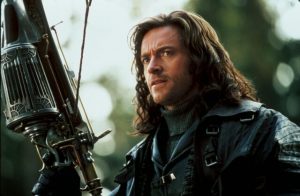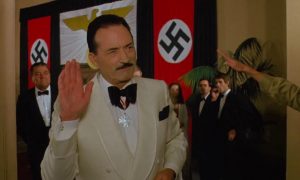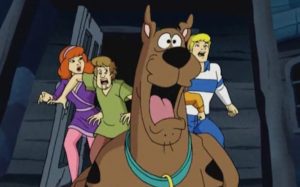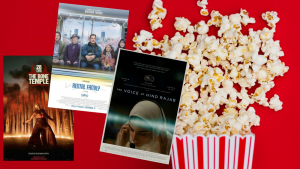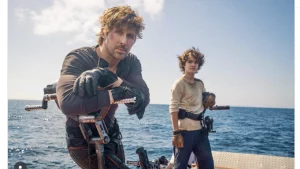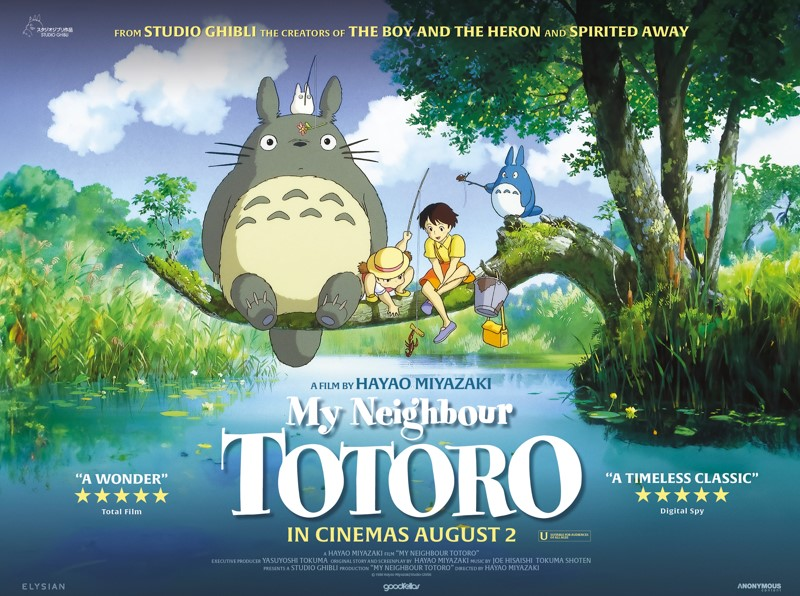
Film Feature by James Learoyd
There is an argument to be made that Japanese animator Hayao Miyazaki is the most important filmmaker living today. His work is not just innovative and groundbreaking in technical terms, but the images him and his team have created have transcended their cinematic roots. Characters at his hand have become staples of Japanese culture and loving obsessions of children and adults around the world, and nowhere is this more apparent than in the case of My Neighbour Totoro – Studio Ghibli’s mascot for over three decades. So, who is Totoro? Well, he’s a big, round, furry spirit creature with disconcertingly large teeth… but he is, of course, much more than that. Totoro, among other things, represents kindness, security and adventure; an escape from the children’s uncomfortable reality in which their mother has taken seriously ill. It’s as simple as a story can be; two kids stumble into a magical world of fantastical creatures. And yet, in 1988, this fairytale would change animation and cinema forever.
It’s a landmark of filmmaking for a multitude of reasons, not least of which is this filmic simplicity. Quaint and beautiful, it genuinely places you in the mindset of the young sisters Satsuki and Mei even if you’re watching as a grown-up. Like most of Miyazaki’s work, a lot of the poetry comes from the nuanced nature of the fantasy world and its fully formed ideas, and this leads to deeply emotional moments. Think, for instance, of the motif of the moonlit Totoro playing a note from his flute while perched on a tree branch; or, it goes without saying, the bus stop scene in the rain – one of the most iconic images in Ghibli’s history.
With moments like these, it comes as delightful news that My Neighbour Totoro is returning to cinemas in the UK and ROI (hence ‘Neighbour’ and not ‘Neighbor’) so that devoted enthusiasts and the newly initiated alike can witness the classic on a proper screen. With this exciting news coming but a year after his Oscar winning masterwork The Boy and the Heron, it’s safe to say that it’s a good time to be a Miyazaki fan.
To celebrate, let us remind ourselves of Hayao Miyazaki’s unmatched body of work and three of the most stunning moments from his movies — these are moments which utilise storytelling and animation as an art form at its purest; to move the viewer in often unexplainable, sensory ways. This is something Miyazaki became more and more adept at doing, unlike any other director of children’s films, over time.
Some of the following analysis I wrote for an unpublished piece on Miyazaki composed a few years ago. Additionally, I have quoted from his two books STARTING POINT: 1979-1996 (VIZ MEDIA, 1996) and TURNING POINT: 1997-2008 (VIZ MEDIA, 2008) – two terrific and comprehensive collections of essays, interviews and lectures by Hayao Miyazaki, translated by Beth Cary and Frederik L. Schodt.
The Simple Joys of Kiki’s Delivery Service
This is my personal favourite of Hayao Miyazaki’s movies and a film I’m comfortable calling my favourite of all time (it’s between that and Robert Altman’s Nashville). Kiki represents optimism in a world so often composed of the opposite. As a young witch going out into the world on the witchy ritual of a full moon, she leaves her home with a stumble, a smile and a spring in her step – ingeniously setting her character up for how she’ll respond to all the hardships found in her year away from home. On her journey in the new village, she encounters humans who take her in and provide her opportunities; however, she also encounters people who dismiss her (with dismissal and a lack of compassion being the greatest of evils within this story). The most wonderfully crafted example of this is that of the old woman wishing to bake a pie for her granddaughter.
Practically an entire act of the film is devoted to Kiki showing enough kindness to assist with the preparation of this gift, and the most subtle yet heart-wrenching element of the encounter becomes the indifferent reaction of the recipient. The secondhand shock and disappointment Kiki experiences at the granddaughter’s response to a loving sentiment is something that pains her in ways she can’t understand and is never resolved.
It’s the most upsetting the film gets, and the maturity of Kiki’s sadness is something so subtle and true that even adults must find its lesson to be cripplingly real. It teaches empathy and compassion, but – on a slightly bitter note – it demonstrates how unfair the world can be. Kiki learns that all she can do is be kind; that you can’t control the feelings and actions of others, and she becomes all the stronger because of it. – This in a kid’s film! During production of Kiki’s Delivery Service, Miyazaki wrote a short essay in which he explains that “our goal in completing this film is to send an expression of solidarity to young viewers who find themselves torn between dependence and independence.” (1988) Clearly part of coming to terms with this transition for Miyazaki is understanding that people are often incomprehensible or even unkind.
Growing Up in Spirited Away
One of the most effective audience surrogates in the entire canon of Miyazaki’s work, Chihiro is introduced to a strange world which is grounded in the realistic struggles of contemporary living. The society and system depicted in Spirited Away proves to be quite harsh: the first thing that Chihiro is instructed to do is attain a job scrubbing in the great bathhouse, otherwise she may cease to exist (not your average fairytale task). As the story progresses, she begins to adapt well to the domineering Yubaba’s social system through the guidance of her friend Haku, but at the film’s end when Chihiro remembers Haku’s non-spirit name, setting him free, a sequence so painfully beautiful and oddly specific is formed.
As the two fall from the night sky, they grasp each other’s hands and float through the air; Chihiro cries tears of joy and exclaims her gratitude, having now remembered that his non-human form was that of a river that inexplicably saved her as a child (to those of you who haven’t seen the film, I realise that this is practically impossible to explain). Joe Hisaishi’s euphoric score swoons as the film reaches its emotional heights, creating a moment that feels as if all the colour and drama is spilling through the screen. It’s vivid, overwhelming and the detail of Chihiro’s tears floating upwards into the sky is simply unbelievable.
Discovering (or Rediscovering) the World with My Neighbour Totoro
Hayao Miyazaki wrote the following in his original project plan for the film: “My Neighbor Totoro aims to be a happy and heartwarming film, a film that lets the audience go home with pleasant, glad feelings. Lovers will feel each other to be more precious, parents will fondly recall their childhoods, and children will start exploring the thickets behind shrines and climbing trees to find a totoro. This is the kind of film I want to make.” (1986) – and if almost forty years of merchandise, artwork and repeat family viewings across generations have demonstrated anything, it’s that he succeeded in this ambitious idea.
On my most recent viewing of the film, I was struck by how much it doesn’t care to differentiate between what is real and what is fantasy; perhaps because, in the mind of a child, there is nothing to differentiate between – no reason to make rational what is inherently otherworldly. And that is what this movie offers which few others do: a fairytale narrative, viewed through the perspective of a child, which need not overexplain its filmic universe, despite being filled with wonderful little details placed there almost for the sake of fun and play (the fascinating design of the cat bus conflicting with the sheer absurdity of a cat being a bus, for example).
“It was a dream, but it wasn’t a dream! It was a dream, but it wasn’t a dream!” These are words exclaimed by sisters Mei and Satsuki during one of the most captivating moments in the movie. Following a day of Mei wishing her seeds to grow with no luck, the children enter the fantasy world wherein Totoro and his spirit buddies magically turn the seeds into a ginormous, majestic tree. The next morning, instead of being upset that the tree is no longer there, they are thrilled that the plants have grown but a few inches… It was a dream, but it wasn’t a dream! – because who cares, it’s all one big adventure! The characters are filled with excitement about the natural world (not necessarily fantasy), and thus the audience are encouraged to reconsider their own world with that very same excitement.
It’s a pleasure to discuss one of my favourite artists, and tracking the evolution of the work’s themes and craft is a deeply fascinating experience, especially when that work is as rich and layered as this. I haven’t even discussed The Wind Rises – the only film of his which effectively takes place in the real world, and one of his crowning achievements as far as I’m concerned; or the delightful Lupin the Third: The Castle of Cagliostro – Miyazaki’s first feature (made before Ghibli formed) which demonstrates that, while his artistic sensibilities have changed, he is a born storyteller.
What better time than now to watch or revisit these gems; what better time than now to re-release such a comfort as Totoro. In our oversaturated landscape of children’s media, we realise that what the films by Hayao Miyazaki and his hardworking team have provided are refined, imaginative and often deeply reflective pieces that embrace the freedom of imagination and encourage empathy. My Neighbour Totoro – a movie as visually awe-inspiring as it is life-affirming – is no exception.
So, do yourself a favour and go see it on the big screen. It’s not an experience to be missed. Thanks to Elysian Film Group and Anonymous Content, both subtitled and dubbed versions of the film will be available in cinemas from August 2nd in the United Kingdom and Republic of Ireland.
Totoro will be there waiting… sitting on his branch, playing his flute…


